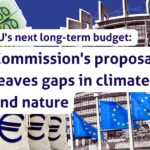On 15 December 2020, the European Commission published its proposal for reforming the EU’s rules for selecting EU energy infrastructure projects for funding and fast-tracking. Unfortunately, despite removing the category of fossil gas projects, the Commission’s proposal does not go far enough in removing the fossil gas industry from its central role in the project selection process, including meaningful sustainability criteria, and ensuring subsidies to fossil fuel projects are removed.
We call on MEPs to address these serious failings to ensure the revised regulation is in line with the Paris climate agreement and limiting temperature increase to 1.5°C by transitioning rapidly away from fossil fuels.
Remove the fossil fuel industry from project selection
The Commission’s proposal to revise the Trans-European Networks Energy (TEN-E) Regulation fails to end the current system that grants fossil gas transport companies, operating through the European Network of Transmission System Operators for Gas (ENTSO-G), undue influence over the selection process for identifying priority EU energy infrastructure projects. If the Commission’s proposal is not significantly revised, ENTSO-G members will remain largely responsible for determining the EU’s gas infrastructure needs and selecting priority energy projects. These projects, known as Projects of Common Interest (PCIs), benefit from fast-tracked planning processes, invaluable political support, and can be eligible for millions in EU subsidies.
Europe’s energy regulators concluded that “(m)ost of the problems that arose during the past implementation of the Regulation could be ascribed to the regulatory role inappropriately attributed to the ENTSOs, despite their conflict of interest” in a joint position paper in June 2020.2 However, the Commission’s proposal offers minor changes, such as small improvements in data transparency and additional oversight by the European Commission and the Agency for the Cooperation of Energy Regulators (ACER). It does not tackle the fundamental conflict of interest created by leaving ENTSO-G in charge of developing the scenarios that underpin the selection of projects and responsible for developing the methodology for the cost-benefit analysis used to help choose projects.
The TEN-E regulation will continue to suffer from a lack of independent and holistic expertise needed to build a decarbonised, interconnected and efficient energy system and will instead remain focused on serving the narrow interests of the gas industry. In the upcoming negotiations, the European Parliament should remove ENTSO-G from its central role in the decision-making process and create a governance system that is genuinely independent and fit for driving the energy transition.
Fossil free infrastructure
The European Commission has proposed to remove fossil gas infrastructure as an eligible category of projects. This is welcome. Since entering into force in 2013, the TEN-E regulation has granted PCI status to 266 fossil gas projects and facilitated nearly €5 billion in taxpayer funded grants and subsidized loans for 41 fossil gas infrastructure projects. A significant share of these projects have been delayed or even abandoned, in part due to increasing local opposition, resulting in a waste of nearly €450 million in EU subsidies.
A study by Artelys found that the gas projects included on the 4th PCI list were not necessary for energy security as existing gas infrastructure is capable of meeting future gas demand scenarios even in cases of extreme supply disruption. Any proposal to reintroduce the fossil gas category would risk wasting even more EU public funds on projects that would quickly become stranded assets. Europe cannot afford to expand and lock-in even more fossil fuel infrastructure if it is to meet its 2030 and 2050 climate and energy targets.
The Commission’s proposal introduces two new gas-related categories: hydrogen and smart gas grids. Both categories create serious risk that the TEN-E regulation will continue to subsidise investments in fossil fuel infrastructure. This is despite the fact that the European Investment Bank (EIB) decided in 2019 to stop financing fossil fuel projects.
As proposed, the hydrogen category includes projects for hydrogen produced from fossil fuels. So-called “low carbon” or “blue hydrogen” relying on carbon capture and storage (CCS) to reduce emissions, is included under this category. However, CCS remains an unproven technology that has failed to materialise at scale despite decades of support and billions in investment. It also does nothing to address upstream emissions from the extraction of fossil gas required to produce this hydrogen. Betting on such a technology is highly risky from a financial and climate perspective.
The new hydrogen category includes a worrying reference to the need for a EU-wide hydrogen network. To contribute to the transition away from fossil fuels, hydrogen must be produced from 100% additional renewable electricity, which means initial volumes will be small. Retrofitting existing pipes for blending hydrogen i.e. adding a percentage of hydrogen to fossil gas should be excluded as it supports the continued use of fossil gas. Another report has shown that it makes more sense to adopt a local approach, locating hydrogen production facilities as close to demand centres as possible. Added to these issues, the cost and technical difficulties involved in transporting hydrogen over long distances means that only localized construction or repurposing of existing gas grids for hydrogen should be considered.
The proposed new smart gas grids category would allow projects aimed at integrating fossil hydrogen or “blue hydrogen” (referred to as “low carbon” gases) and potentially unsustainable biogas investments into the gas grid. The EU already has a poor track record of supporting unsustainable biomass and biofuels. The introduction of this new category is not properly justified, and is likely to provide little benefit for the consumer. The smart gas grid category should either entirely exclude fossil and fossil-based gases as well as unsustainable biomethane projects, or be deleted.
Finally, the Commission did not remove carbon dioxide pipeline projects. These projects are linked to the technology of CCS or CCU (utilisation of carbon dioxide to extract more fossil fuels). For reasons already stated, CCS should not benefit from EU subsidies and this category should be removed.
Meaningful sustainability criteria
The TEN-E regulation and the selection of projects are part of EU energy policy and therefore must respect the principle of integration of environmental protection requirements, and in particular promote sustainable development12. The Commission’s inclusion of sustainability as priority criteria across most infrastructure categories is welcome. However, a clear definition of the criteria is lacking.
Without a proper definition of sustainability in the TEN-E regulation, there is a risk that the definition is created during the PCI selection process. This would be far from ideal as ENTSO-G does not have a good track record in this area. Indeed, the current sustainability assessment by ENTSO-G consists of comparing fossil gas projects against coal or oil projects. ENTSO-G’s failure
to conduct adequate climate impacts for fossil gas projects was acknowledged by the European Ombudsman last year.
The climate and environmental impact of any gas-related project should be evaluated against the cleanest available technology. For example, the Commission only proposes to set a greenhouse gas emission savings requirement of at least 70 percent for the ‘electrolyser’ category. The threshold should be increased to reflect the 80 percent threshold for greenhouse gas emission savings in order to be consistent with the proposal in the draft Delegated Act of the Taxonomy regulation, and applied to all categories of PCI projects.
This new definition of sustainability should refer to full life-cycle greenhouse gas emissions, to ensure other greenhouse gases such as methane, including for biogas projects, are taken into account. Biogas projects also need multiple sustainability criteria, including a requirement that only locally sourced agricultural and forest waste and residues should be allowed as feedstocks for biogas projects to be eligible for PCI status.



